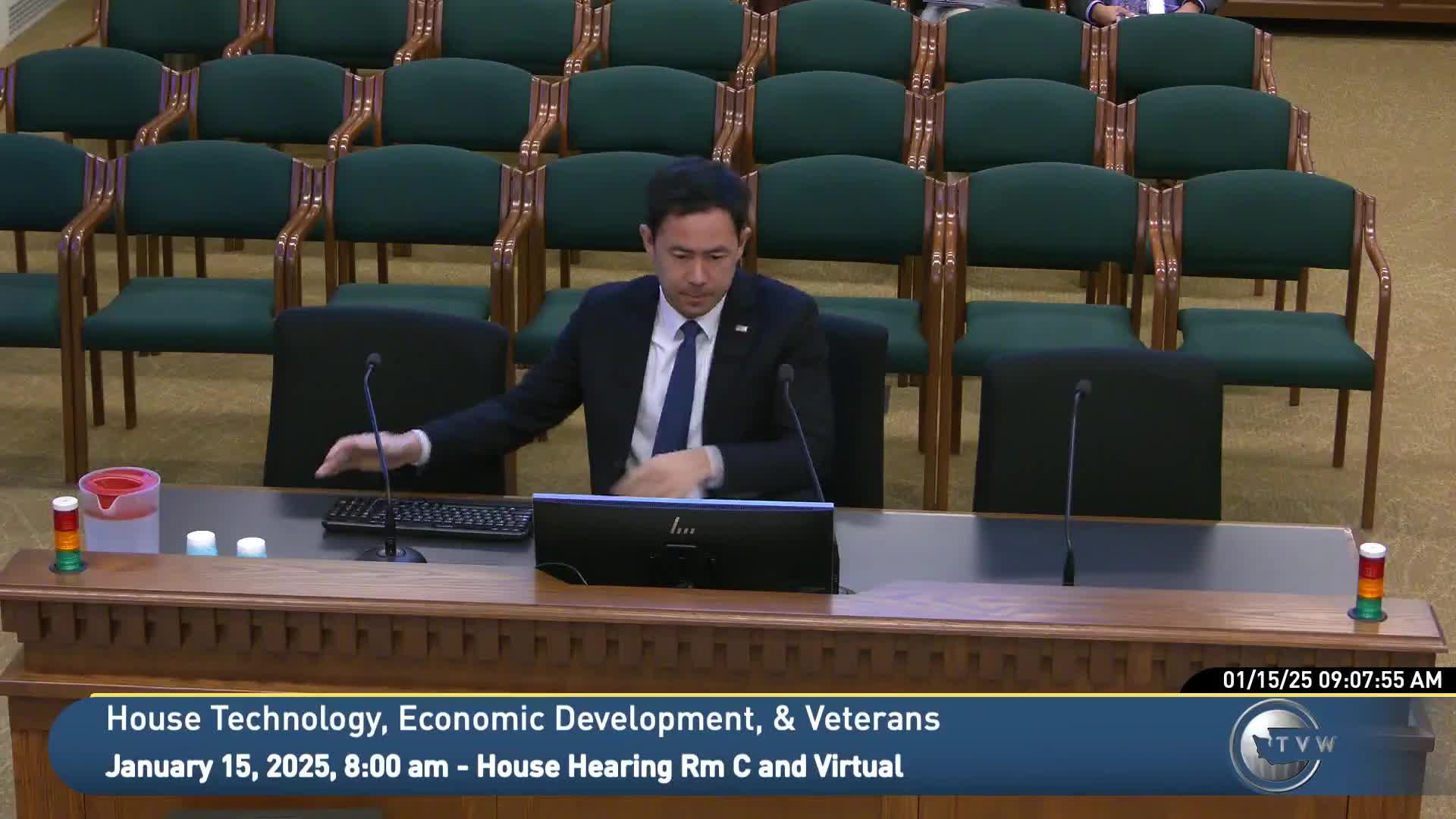Committee hears bill to expand veteran service officers and outreach to recently separated veterans
January 15, 2025 | Innovation, Community & Economic Development, & Veterans, House of Representatives, Legislative Sessions, Washington
This article was created by AI summarizing key points discussed. AI makes mistakes, so for full details and context, please refer to the video of the full meeting. Please report any errors so we can fix them. Report an error »

The Technology, Economic Development and Veterans Committee held a hearing on House Bill 1102, which would expand access to veteran service officers (VSOs), require the Washington Department of Veterans Affairs to contact recently separated veterans, and require biennial reporting on veteran-service outcomes.
Martha Whaling, committee staff, briefed members that the bill would change the eligibility criteria for counties to receive VSO funding from a fixed population threshold to a priority system based on counties where the percentage of veterans receiving federal disability or pension compensation is below the national average. The change would expand eligible counties from 25 to 36 and would require WDVA to prioritize counties most below the national average.
Representative Clyde Shavers, prime sponsor, said the bill “represents a promise to our veterans” and argued federal and state benefits are difficult to navigate without trained VSOs. He cited WDVA data that 10 counties have no VSO and that only eight counties meet or exceed the national average for veterans receiving federal disability compensation.
David Fuente, director of the Washington State Department of Veterans Affairs, testified the agency partners with counties, tribes and nonprofit VSOs and currently funds six county VSO positions. He said about 162,000 Washington veterans receive VA disability compensation monthly, with an average payment of roughly $1,800 per month; WDVA estimated those payments return roughly $3.6 billion annually to the state economy. Fuente said the federal VA publishes national figures each year and that WDVA receives transition data that helps contact servicemembers moving into Washington.
Witnesses including Jerry Fudrick, chairman of the Veterans Legislative Coalition, and other veterans’ organizations voiced unanimous support for HB 1102. Committee members asked about fiscal impacts, how WDVA would find veterans who move to the state and the data source for the national average; WDVA said federal VA publishes the national figures and the agency currently receives transition location data.
The bill would also require WDVA to report every two years beginning December 2026 on veteran population, services available and successful claims, and to report counties below the national average or lacking a VSO. Testimony concluded with WDVA describing existing VSO capacity (23 counties served by current partners, 6 funded officers) and with requests for continued legislative support to expand coverage.
Martha Whaling, committee staff, briefed members that the bill would change the eligibility criteria for counties to receive VSO funding from a fixed population threshold to a priority system based on counties where the percentage of veterans receiving federal disability or pension compensation is below the national average. The change would expand eligible counties from 25 to 36 and would require WDVA to prioritize counties most below the national average.
Representative Clyde Shavers, prime sponsor, said the bill “represents a promise to our veterans” and argued federal and state benefits are difficult to navigate without trained VSOs. He cited WDVA data that 10 counties have no VSO and that only eight counties meet or exceed the national average for veterans receiving federal disability compensation.
David Fuente, director of the Washington State Department of Veterans Affairs, testified the agency partners with counties, tribes and nonprofit VSOs and currently funds six county VSO positions. He said about 162,000 Washington veterans receive VA disability compensation monthly, with an average payment of roughly $1,800 per month; WDVA estimated those payments return roughly $3.6 billion annually to the state economy. Fuente said the federal VA publishes national figures each year and that WDVA receives transition data that helps contact servicemembers moving into Washington.
Witnesses including Jerry Fudrick, chairman of the Veterans Legislative Coalition, and other veterans’ organizations voiced unanimous support for HB 1102. Committee members asked about fiscal impacts, how WDVA would find veterans who move to the state and the data source for the national average; WDVA said federal VA publishes the national figures and the agency currently receives transition location data.
The bill would also require WDVA to report every two years beginning December 2026 on veteran population, services available and successful claims, and to report counties below the national average or lacking a VSO. Testimony concluded with WDVA describing existing VSO capacity (23 counties served by current partners, 6 funded officers) and with requests for continued legislative support to expand coverage.
View full meeting
This article is based on a recent meeting—watch the full video and explore the complete transcript for deeper insights into the discussion.
View full meeting
